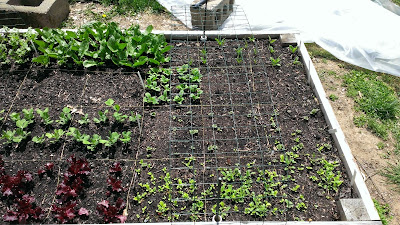Can't beat the heat
A few hot days in May and everything starts to bolt! If you are unfamiliar with the term...let me splain. No it's to much...let me sum up. When a plant "bolts" it means it is going to seed. OrganicGardening@About.com does a lovely job defining "Bolting." Typically, lettuce, spinach or some more tender leafy greens will suddenly sprout a flower stalk and in just a few days, there is a lovely flowering plant where your spinach used to be. Or in my case, spinach, arugula and cilantro...all bolting with a few days of each other. The cilantro is quite beautiful once it has gone to flower. I left a few standing to aid in keeping the evil doers (bad bugs) away, but the heavy rain over the past few days quite literally beat it down and only 1 still stands. I described this to my friend Robin, who is starting her first garden this year (DO YO THANG!) and her response was, "What's the point of growing them?" Well, that is an excellent point. One cannot determine what curve ball nature will throw our way on any given day, much less any growing season.
So what is the point of growing these beautiful greens if only a few short weeks after you may have dropped them into the ground, they are bolting and gone for the season?
That is one hell of a heading! Well, as a wise man (or woman for that matter) once said, "Timing is EVERYTHING." It is important that you take into account the information that is widely available regarding the types of plants you grow and the approximate dates they should be planted. Many times that information is right on the back of your newly purchased seed packet...and then there are other times when you have seeds and there is no information whatsoever on when and how to plant them. Please see below. |
| On the left, lots of useful information...on the right, zip, zilch, nada. |
Here is the Sisk Family Farm as of 5/20/13.
Here are my Mortgage Lifter Tomatoes (left) Super Sweet Cherry Tomatoes (right of center), Sweet Banana Peppers and Red Bell Peppers (right edge).
Mesclun greens in front, Mustard greens next, Champion Radish behind and to the left.
My pride and joy...Lupine, flowering beautifully!
Arugula (left), Lupine behind (you can see the one and only flower), Red Russian Kale, Tuscan Kale, more Arugula and finally Yellow Onions.
Other half of the earlier bed, Romaine (left), Lolla Rosa, Peas behind them and the Spinach and Cilantro in the rear, just prior to being harvested for the last time this spring. I created a trellis for the peas to grow up on and they seem to be utilizing it as I had hoped. I snuck in some Sweet Corn that I started in my basement in late winter between the peas and cilantro. It is hard to see, but I hope that changes in the next few weeks.
Last but not least, Pac Choi (left), a singular flowering Broccoli Rabe, Chinese Kale/Broccoli in the center and Chard on the right.
The weather is perfect for planting...and so I am off to sow some Black Valentine Bush Beans, Blue Coco Beans, Hericot Vert Bush Beans, Champion Radish, Mucher Cucumber, Nasturtium and Yukon Gold Potatoes.
Wish me luck!










